Orchids, oleanders, oxeye daisies, oh my! When it comes to the vibrant world of flora, there are a surprising number of flowers that start with O. The variety is astounding, ranging from the exotic opulence of orchids to the humble charm of oxalis.
Ready to embark on a fascinating journey into the realm of O-initialed flowers? Whether you’re a seasoned botanist or a blossoming flower enthusiast, there’s something for everyone to uncover in this colorful exploration of flowers that starts with O.
1. Orchid
Classification: Orchidaceae spp.
The first entry on our guide to flowers that start with O is the ever-recognizable orchid. Orchids are amazing and alluring flowers that come in a wide variety of sizes, colors, and forms. Orchids are renowned for their grace and beauty and are truly amazing works of nature. The complex petals and frequently complicated patterns on these beautiful flowers give them a distinctive appearance that is reminiscent of delicate and ornate works of art. Orchids come in a broad range of colors that may enthrall any viewer, from intense colors like deep purple and blazing orange to delicate pastels and pure white.
Orchids are throughout the world, including in deserts, mountains, and tropical rainforests. They have thrived in a variety of climates and environments thanks to their extraordinary adaptability. Epiphytic orchids are those that grow on trees, whereas terrestrial orchids are those that grow on the ground. Some even exhibit their adaptation and toughness by growing on rocks.
Orchids have several advantages over just being beautiful. By luring pollinators like bees, butterflies, and birds, they help other plants reproduce by facilitating their pollination. In addition, orchids have long been utilized in traditional medicine for therapeutic purposes. They include substances that have the potential to cure a variety of conditions, including infections and inflammation. Just as well, orchids are treasured in the horticulture sector, where they are raised and developed to produce novel and distinctive types, adding to the delight and awe of gardeners throughout the world.

Orchids have unusually and intricately colored flowers.
©iStock.com/sutan abraham
2. Osmanthus
Classification: Osmanthus spp.
Osmanthus flowers are enticing flowers that start with O with an exquisite and tempting aroma, making them a gem in the world of botany. They have succeeded in winning over the hearts of flower lovers all over the world with their allure of beauty and fragrance.
The Osmanthus genus, which includes a wide range of shrubs and trees, is the source of these lovely blooms. Small and grouped, the Osmanthus plant’s flowers produce an astounding display of color and scent. They often have a feeling of elegance and grace and are colors of white, yellow, or orange. Their sweet, seductive aroma, which has been compared to a harmonic fusion of floral and fruity overtones, fills the air when they are in full bloom.
Osmanthus blooms are found throughout the world, but are particularly common in East Asia, including China and Japan, where they have special cultural importance. They are valued in these areas for their symbolic meaning and are frequently used in festivities and auspicious occasions.
Osmanthus blooms are beautiful, but they also have several useful advantages. Their pungent fragrance frequently adds a touch of elegance and charm to perfumes, scented candles, and incense. The blooms are used to prepare herbal tea in traditional Chinese medicine, which is prized for its relaxing effects and alleged health advantages.
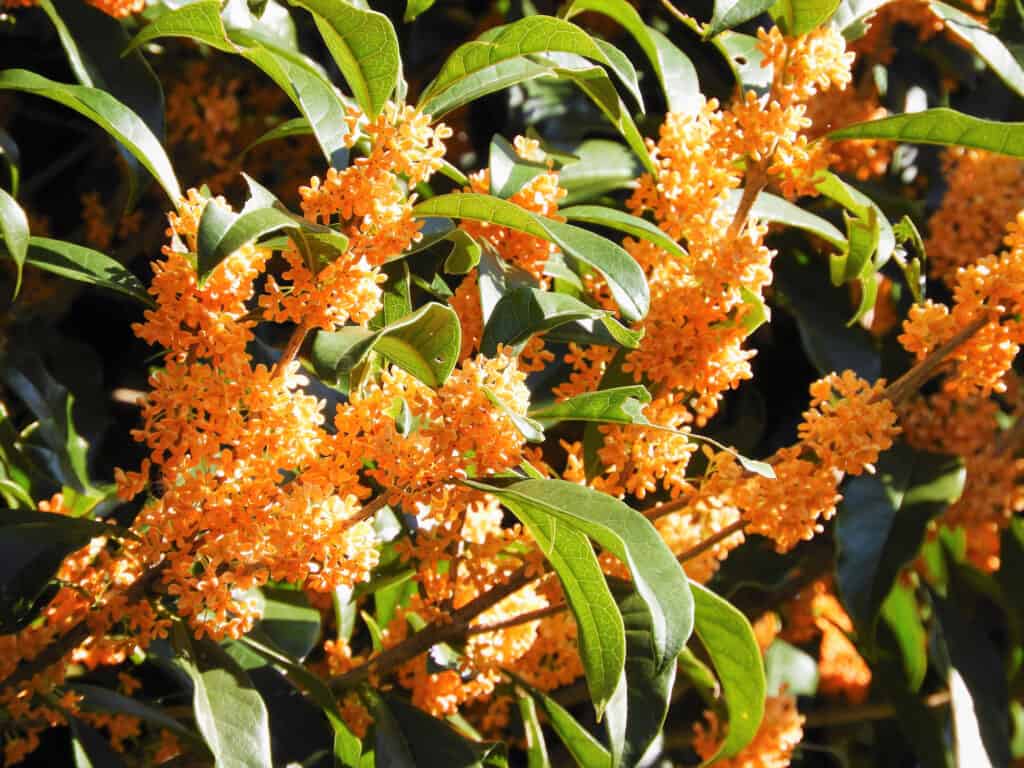
Osmanthus is known for its beautiful landscaping appeal in addition to its use in perfumes and medicine.
©iStock.com/Chiemi Kumitani
3. Oxeye Daisy
Classification: Leucanthemum vulgare
Oxeye daisy flowers, with their radiant and cheerful appearance, are enchanting botanical gems that grace fields and meadows with their presence. These flowers that start with O belong to the daisy family and are renowned for their resilience and adaptability in various environments.
The oxeye daisy’s distinctive charm lies in its captivating features. Each flower boasts a vibrant yellow center, resembling a golden sun, surrounded by pristine white petals that create a delicate and captivating contrast. With their simple yet captivating beauty, these flowers have a timeless appeal that captivates both the young and the young at heart.
In terms of habitat, oxeye daisies are versatile and are in different regions of the world, from Europe to North America. They thrive in open grasslands, meadows, and even roadside verges, adding a touch of color and liveliness to these landscapes. Their ability to grow in diverse conditions has contributed to their widespread distribution and popularity.
Beyond their aesthetic allure, oxeye daisies provide ecological benefits. Their nectar-rich flowers attract various pollinators, including bees and butterflies, promoting biodiversity and supporting the reproduction of other plants. Furthermore, these hardy flowers have a knack for stabilizing soil, preventing erosion, and enhancing the fertility of the surrounding environment.
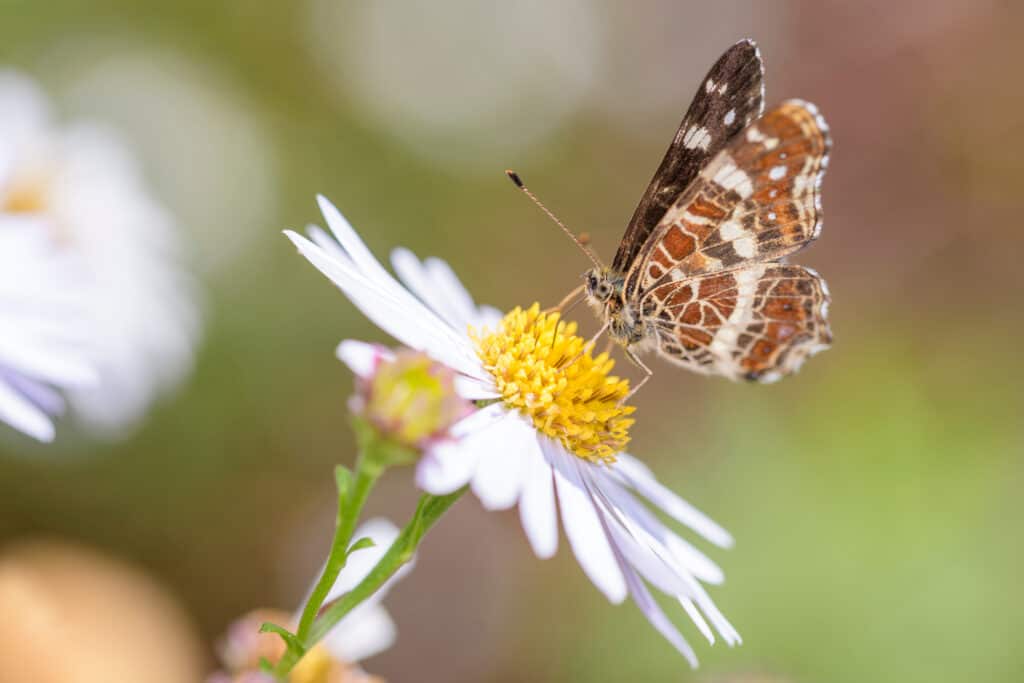
Oxeye daisies are excellent flowers for attracting beneficial pollinators.
©Dirk Daniel Mann/Shutterstock.com
4. Orlaya
Classification: Orlaya grandiflora
Orlaya flowers, with their ethereal beauty and delicate charm, are captivating flowers that start with O that grace gardens and landscapes with their enchanting presence. These exquisite flowers belong to the Orlaya genus, a group of plants that are treasured for their graceful appearance and unique characteristics.
The allure of orlaya flowers lies in their intricate structure and captivating petals. Each blossom features a cluster of delicate, lacy petals that resemble delicate lacework, creating an enchanting and romantic atmosphere. The petals are typically pure white, radiating a sense of purity and elegance, while the center of the flower holds a delicate arrangement of tiny florets, adding to their enchanting allure.
Orlaya flowers can be found in various regions, particularly in Europe and parts of Asia. They are known to flourish in sunny or partially shaded areas, and their ability to adapt to different climates has contributed to their popularity among gardening enthusiasts.
Apart from their aesthetic appeal, orlaya flowers have practical benefits as well. They are known to attract beneficial insects such as bees and butterflies, promoting pollination and contributing to the overall health of the ecosystem.
5. Oriental Lily
Classification: Lilium orientalis
Oriental lily flowers, with their exquisite beauty and captivating fragrance, are flowers that start with O that have enraptured the senses of flower enthusiasts for generations. These alluring blooms belong to the Lilium genus, a group of flowers renowned for their elegance and charm.
The Oriental lily’s allure lies in its striking appearance and intoxicating scent. Each flower boasts large, showy petals that unfurl gracefully, revealing intricate patterns and vibrant colors. They come in a diverse range of shades, from pure whites and soft pinks to deep purples and fiery oranges, adding a touch of opulence and drama to any floral arrangement. But it is their fragrance that truly sets them apart. The perfume emanating from Oriental lilies is sweet and heady, filling the air with an enchanting aroma that can transport one to a world of tranquility and beauty.
These captivating flowers are in various parts of the world, particularly in Asia. They prefer well-drained soil and a sunny location to thrive, and their majestic presence often graces gardens, bouquets, and even special events like weddings and celebrations.
Beyond their aesthetic and olfactory appeal, Oriental lilies hold symbolic and cultural significance. In many cultures, they are associated with purity, love, and prosperity, making them popular choices for gifts and decorations during auspicious occasions.
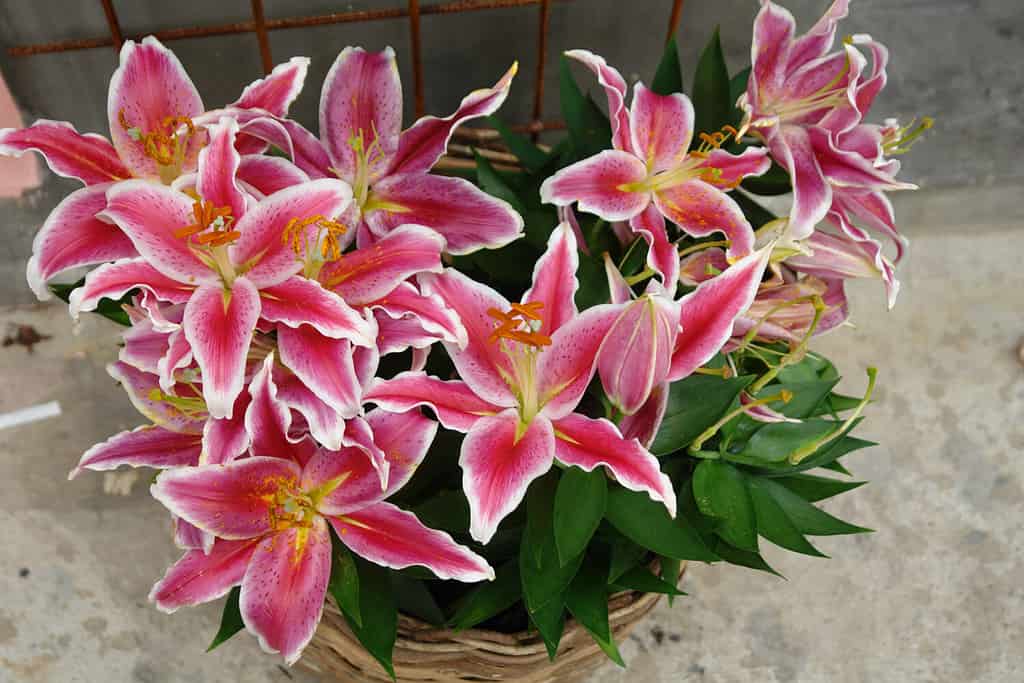
While Oriental lilies are poisonous to pets, so plant them with caution.
©ahmydaria/Shutterstock.com
6. Oleander
Classification: Nerium oleander
Oleander flowers have a mesmerizing beauty and vibrant hues. They are botanical marvels that grace landscapes with their presence. These captivating blooms belong to the Oleander genus, a group of plants admired for their striking appearance and versatility.
The allure of oleander flowers lies in their unique characteristics. Each blossom boasts clusters of delicate, trumpet-shaped petals that come in a wide array of colors, including shades of pink, white, and vibrant red. Their petals often possess a subtle gradation of hues, creating a stunning visual effect that captures the eye and sparks wonder. The flowers are also known for their pleasant fragrance, which perfumes the surrounding air with a delightful and captivating scent.
Oleander flowers are in various regions around the world, thriving in warm and sunny climates. Their adaptability and resilience have made them a popular choice for gardens, parks, and even coastal landscapes. Despite their delicate appearance, oleanders are hardy plants that can withstand drought and thrive in a range of soil conditions.
It is essential to note, however, that while oleander flowers are undeniably beautiful, they are also toxic if ingested. The plant contains compounds that can be harmful, making it important to exercise caution when handling or growing them.
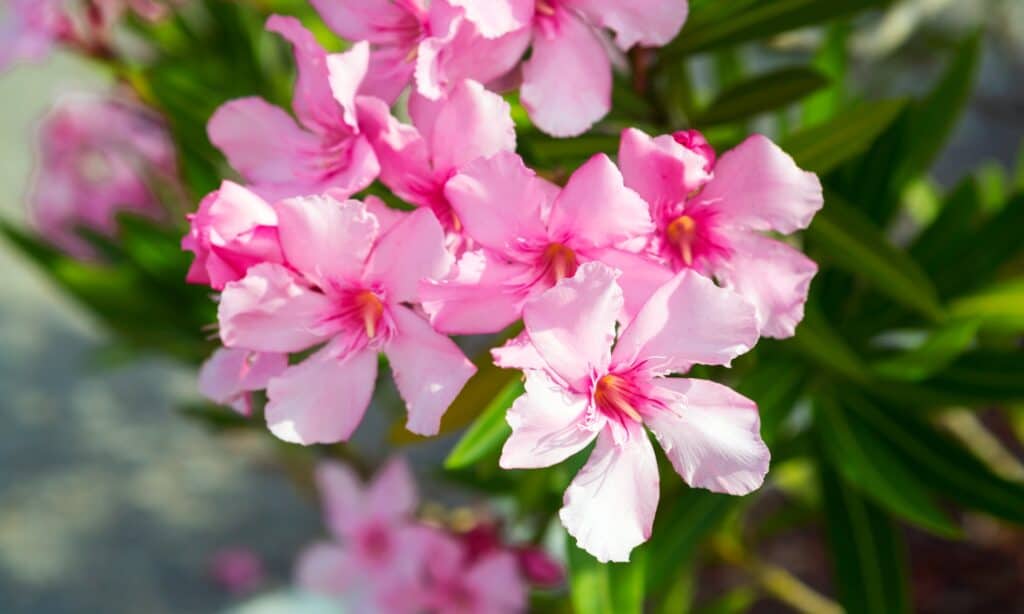
Oleanders are delicate flowers that can be poisonous to pets in addition to humans.
©iStock.com/Katrin_Timoff
7. Oenothera
Classification: Oenothera spp.
Evening primroses, sometimes referred to as Oenothera flowers, are lovely blossoms that add a delicate and ethereal touch to gardens and meadows. These alluring blooms are a part of the Oenothera genus, a large family of plants renowned for both their beauty and toughness.
Oenothera flowers are attractive because of their distinctive qualities. Each flower has delicate petals that open up in the evening, producing a stunning display in the moonlight. They are available in a variety of colors, such as delicate pinks, yellows, and whites, and they exude peace and grace. The petals frequently have elaborate patterns and textures, which furthers their allure. These flowers leave an unforgettable impact on those who are lucky enough to see their fleeting show, even when their petals disappear with the dawn.
Oenothera flowers are widespread across the world and thrive in temperate and subtropical climates. They frequently embellish meadows, roadside edges, and other natural environments, giving their surroundings a magical touch. These flowers are a favorite among gardeners. Their versatility and capacity to grow in a variety of soil types make them a top choice.
Oenothera flowers provide therapeutic benefits in addition to their beauty. Due to their possible medicinal value, certain species of evening primrose are part of traditional medicine. The essential fatty acid-rich oil derived from their seeds has been used for its anti-inflammatory and skin-nourishing qualities.
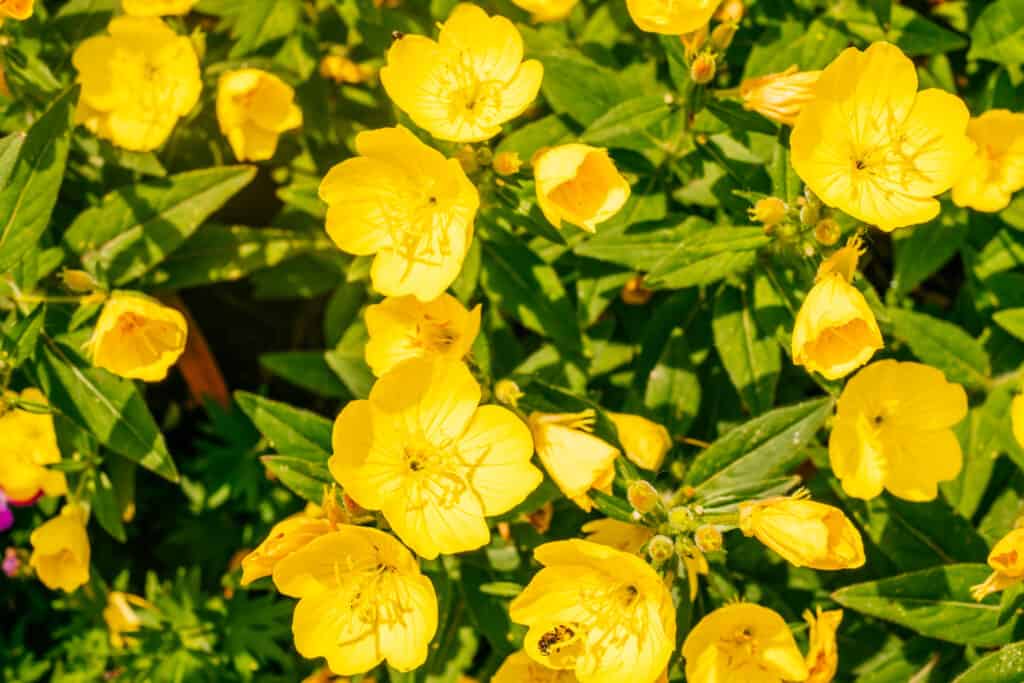
Oenothera flowers have the appearance of little yellow cups, which gives them aesthetic appeal.
©iStock.com/Christina Vartanova
8. Osteospermum
Classification: Osteospermum spp.
The beautiful floral beauties known as osteospermum flowers, often called African daisies or Cape daisies, dazzle gardens and landscapes with their brilliant hues and gorgeous petals. These alluring blossoms are a part of the Osteospermum genus.
Osteospermum blooms are attractive due to their remarkable beauty and adaptability. Each flower displays an exquisite symphony of petals in a variety of alluring hues. These flowers fascinate the sight and spark the imagination, whether they are in delicate pastels like lilac and peach or striking colors like electric blue and magenta. Their petals frequently have elaborate patterns and textures, which elevate and complicate an already magical presentation.
Native to South Africa, osteospermum blooms flourish in sunny, well-drained conditions, especially in the Cape area. But because of their versatility and capacity to tolerate a variety of environmental situations, they have grown in favor all over the world. These blooms provide a colorful and uplifting touch to any outdoor location, making them a favorite among gardeners and landscaping aficionados.
9. Orange Blossom
Classification: Citrus sinensis
The fragrant orange blossom enchants the senses and conjures up visions of sun-dappled gardens. From the citrus tree family, these alluring blossoms, sometimes known as neroli flowers, are prized for their delicate allure and cultural importance.
Orange blooms are seductive because of their charming aroma and delicate look. Each flower has a cluster of tiny, graceful white petals that radiate beauty. The blossoms have a seductive scent that dances in the air in a symphony of citric and floral notes, evoking a tranquil and joyful mood. Neroli oil, an essence from orange blossoms, and in use for centuries in aromatherapy and perfumery because of its energizing and relaxing qualities.
Orange blooms are in several places with a climate that is favorable for growing citrus, including the Mediterranean and subtropical regions. These flowers represent plenty, purity, and festivity in many civilizations and are frequently in connection to hot, sunny environments. In traditional rituals, weddings, and festivals, they are a treasured presence. They often adorn brides, floral wreaths, and bouquets due to their lovely scent.
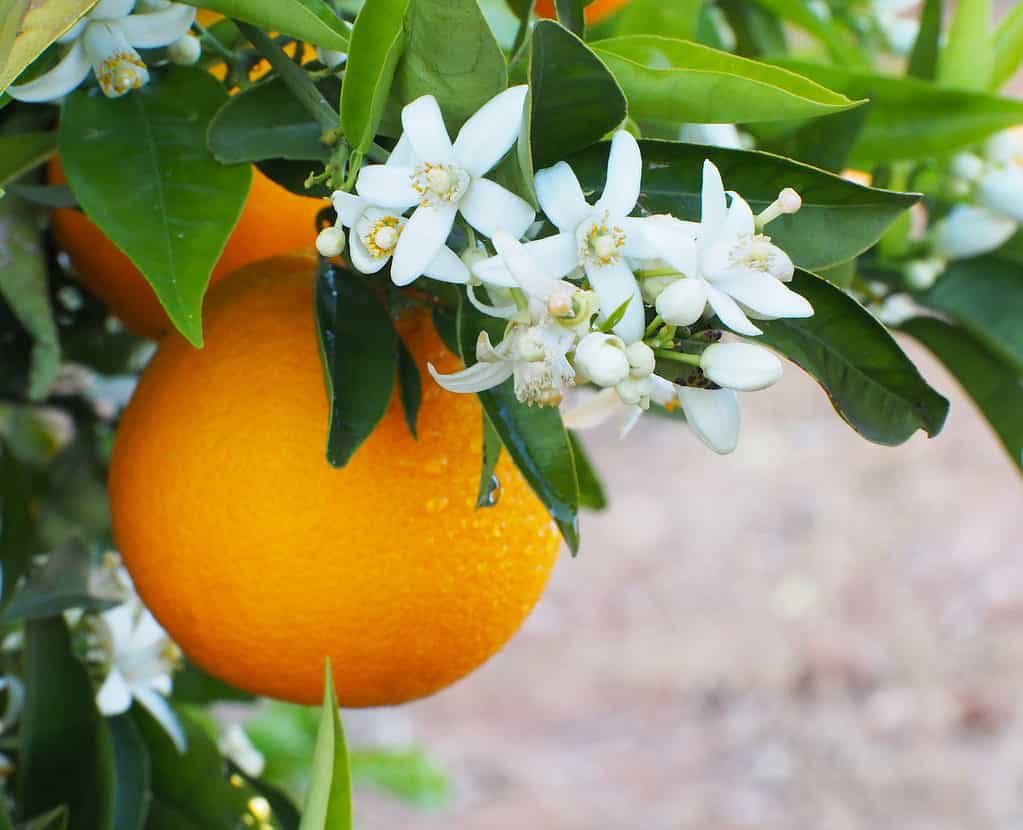
Orange blossoms add a splash of pure white to the green and orange hues of fruiting orange trees.
©Iness_la_luz/Shutterstock.com
10. Oxalis
Classification: Oxalis spp.
Oxalis, commonly known as wood sorrels or shamrocks, are delightful plants that grace gardens and natural landscapes with their dainty foliage and vibrant flowers. These captivating herbs belong to the Oxalis genus, a diverse group of plants celebrated for their charm and versatility.
Oxalis plants possess unique characteristics that set them apart. They boast delicate, trifoliate leaves that resemble clover, giving rise to their association with luck and good fortune. The leaves can come in various shades of green and even purplish tones. This adds a touch of whimsy to their appearance. Additionally, oxalis plants produce enchanting flowers that bloom in an array of colors, including cheerful yellows, pinks, and whites. These blossoms, often with five petals, create a captivating display that adds a burst of color to any setting.
Oxalis are in diverse habitats around the world, from woodlands to meadows and even as houseplants. They are adaptable and thrive in both sunny and shaded environments. Their versatility has made them a popular choice for gardens and indoor ornamental plants. They add a touch of natural beauty to any space.
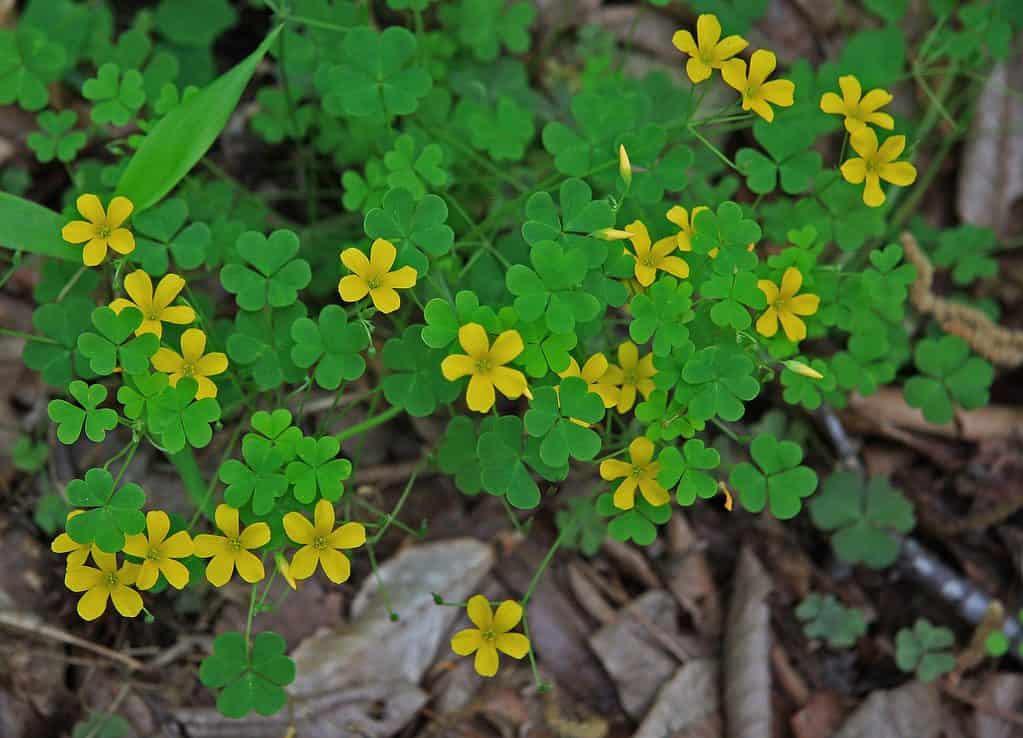
Oxalis flowers are worldwide, and they are commonly in woodland areas.
More Beautiful Flowers That Start With O
| # | Flower | Classification |
|---|---|---|
| 1 | Orchid | Orchidaceae spp. |
| 2 | Osmanthus | Osmanthus spp. |
| 3 | Oxeye Daisy | Leucanthemum vulgare |
| 4 | Orlaya | Orlaya grandiflora |
| 5 | Oriental Lily | Lilium orientalis |
| 6 | Oleander | Nerium oleander |
| 7 | Oenothera | Oenothera spp. |
| 8 | Osteospermum | Osteospermum spp. |
| 9 | Orange Blossom | Citrus sinensis |
| 10 | Oxalis | Oxalis spp. |
| 11 | Obedient Plant | Physostegia virginiana |
| 12 | Ornithogalum | Ornithogalum spp. |
| 13 | Olearia | Olearia spp. |
| 14 | Onopordum | Onopordum acanthium |
| 15 | Osmunda | Osmunda spp. |
| 16 | Oxypetalum | Oxypetalum coeruleum |
| 17 | Othonna | Othonna spp. |
| 18 | Oxalis Triangularis | Oxalis triangularis |
| 19 | Osmorhiza | Osmorhiza spp. |
| 20 | Oriental Poppy | Papaver orientale |
The photo featured at the top of this post is © Ulrike Adam/Shutterstock.com
Thank you for reading! Have some feedback for us? Contact the AZ Animals editorial team.







